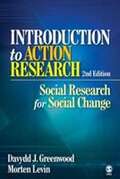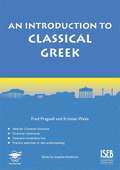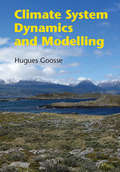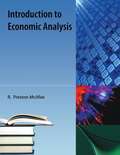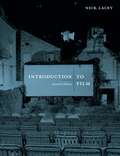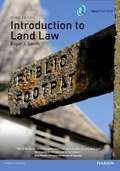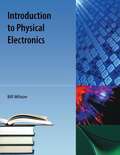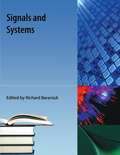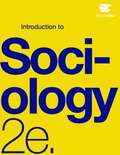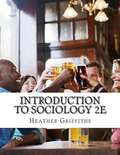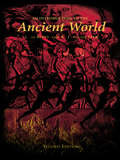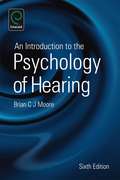- Table View
- List View
Introduction to Action Research (PDF): Social Research for Social Change
by Davydd J. Greenwood Morten LevinHow do social researchers know how to select the action research (AR) approach that is most appropriate for their study? Aimed at providing newcomers to AR with the different approaches they seek, Introduction to Action Research, 2/e introduces the history, philosophy, social change agenda, methodologies, ethical arguments for, and fieldwork tools of AR. The book opens with a brief presentation of two cases of AR. This is followed by chapter on the philosophical and methodological arguments for AR as a form of scientific inquiry that better meets scientific standards than what is currently called "social science" in academia. The authors next explore the marginalization of AR activities in academia, followed by four cases drawn from the authors own practice, including some examples of failures. Two new chapters engage the student and researcher into the current debates on action research as "tradition" or its own "methodology", and how action research takes shape in the university environment. In the final section of the book the authors cover six different approaches to doing AR. Throughout the book, the authors employ a consistent AR praxis supported by suitable methods and tools to integrate a philosophical, methodological, and political economic position to view the different kinds of AR practices. Introduction to Action Research provides experienced researchers and practitioners with more appropriate and productive ways of using AR for conducting social research.
An Introduction to Christian Ethics for CCEA GCSE (PDF)
by Juliana GilbrideComprehensively updated to address the revised CCEA GCSE specification for Religious Studies, this book covers Unit 6: 'An Introduction to Christian Ethics' of the specification. Full colour and illustrated throughout with questions and activities. Also available is a Digital Resource designed to be used with the textbook.
An Introduction to Classical Greek (Level 1/2) (PDF)
by Kristian Waite Fred PragnellThis textbook is ideal for any pupil working towards Level 1 or Level 2 of the Common Entrance Classical Greek exam at 13+. It introduces pupils to Greek grammar and vocabulary and features clear explanations and challenging practice questions to help pupils develop their exam technique. Several unseen passages are also included, to help pupils perfect their translation skills. Suitable for ISEB 13+ Greek exams up to and including Summer 2014. - Endorsed by ISEB - Ideal for pupils working towards Levels 1 or Level 2 of the Classical Greek Common Entrance exam at 13+ - Introduces pupils to essential Greek grammar and vocabulary - Features clear explanations followed by extensive practice questions so pupils can check what they have learnt - Unseen passages to help pupils perfect their translation skills are also included An Answer Book is also available to accompany this book. 9781905735860
Introduction to Climate Dynamics and Climate Modeling
by Goosse H. W. Lefebvre V. Zunz P. Y. Barriat M. F. LoutreAn open source textbook. Bookshare demo title.
An Introduction to Compressive Sensing
by Wotao Yin Mona Sheikh Jason LaskaIntroduction to compressive sensing. This course introduces the basic concepts in compressive sensing. We overview the concepts of sparsity, compressibility, and transform coding. We then review applications of sparsity in several signal processing problems such as sparse recovery, model selection, data coding, and error correction. We overview the key results in these fields, focusing primarily on both theory and algorithms for sparse recovery. We also discuss applications of compressive sensing in communications, biosensing, medical imaging, and sensor networks.
Introduction to Contracts, Sales and Product Liability
by Don Mayer Daniel M. Warner George J. Siedel Jethro K. LiebermanMayer, Warner, Siedel and Lieberman's Introduction to Contracts, Sales and Product Liability is an up-to-date textbook that includes legal issues that are covered in an introductory business law course. The text is organized to permit instructors to tailor the materials to their particular approach. The authors take special care to engage students by relating law to everyday events with their clear, concise and readable style.
Introduction to Economic Analysis
by R. Preston McafeeThis book presents introductory economics ("principles") material using standard mathematical tools, including calculus. It is designed for a relatively sophisticated undergraduate who has not taken a basic university course in economics. It also contains the standard intermediate microeconomics material and some material that ought to be standard but is not. The book can easily serve as an intermediate microeconomics text. The focus of this book is on the conceptual tools and not on fluff. Most microeconomics texts are mostly fluff and the fluff market is exceedingly over-served by $100+ texts. In contrast, this book reflects the approach actually adopted by the majority of economists for understanding economic activity. There are lots of models and equations and no pictures of economists.
Introduction to Economic Analysis
by R. Preston Mcafee Tracy R. LewisThis book presents standard intermediate microeconomics material and some material that, in the authors' view, ought to be standard but is not. Introductory economics material is integrated. Standard mathematical tools, including calculus, are used throughout. The book easily serves as an intermediate microeconomics text, and can be used for a relatively sophisticated undergraduate who has not taken a basic university course in economics. The focus of this book is on the conceptual tools and not on fluff. As such, it reflects the approach actually adopted by the majority of economists for understanding economic activity. There are lots of models and equations, and no pictures of economists ;-) Economic analysis is used in many situations. When British Petroleum sets the price for Alaskan crude oil, it uses an estimated demand model, both for gasoline consumers and also for the refineries to which BP sells. Economic analysis was used by experts in the antitrust suit brought by the U.S. Department of Justice both to understand Microsoft s incentive to foreclose (eliminate from the market) rival Netscape and consumer behavior in the face of alleged foreclosure. Stock market analysts use economic models to forecast the profits of companies to predict the price of their stocks. When the government forecasts the budget deficit or considers a change in environmental regulations, it uses economic models. This book presents the building blocks of the models in common use by an army of economists thousands of times per day. This book, plus econometrics, provides most of the economic analysis tools to take upper division economics courses of any type.
Introduction to Economic Analysis
by R. Preston Mcafee Tracy R. LewisThis book presents standard intermediate microeconomics material and some material that, in the authors' view, ought to be standard but is not. Introductory economics material is integrated. Standard mathematical tools, including calculus, are used throughout. The book easily serves as an intermediate microeconomics text, and can be used for a relatively sophisticated undergraduate who has not taken a basic university course in economics. The focus of this book is on the conceptual tools and not on fluff. As such, it reflects the approach actually adopted by the majority of economists for understanding economic activity. There are lots of models and equations, and no pictures of economists ;-) Economic analysis is used in many situations. When British Petroleum sets the price for Alaskan crude oil, it uses an estimated demand model, both for gasoline consumers and also for the refineries to which BP sells. Economic analysis was used by experts in the antitrust suit brought by the U.S. Department of Justice both to understand Microsoft s incentive to foreclose (eliminate from the market) rival Netscape and consumer behavior in the face of alleged foreclosure. Stock market analysts use economic models to forecast the profits of companies to predict the price of their stocks. When the government forecasts the budget deficit or considers a change in environmental regulations, it uses economic models. This book presents the building blocks of the models in common use by an army of economists thousands of times per day. This book, plus econometrics, provides most of the economic analysis tools to take upper division economics courses of any type.
Introduction To Film
by Nick LaceyThis core textbook offers a concise yet complete introduction to film, responding to shifts in the medium while addressing all of the main approaches that inform film studies. The rise of on demand internet-based video has transformed the way films are distributed and exhibited, with many previously unobtainable and obscure films becoming available for global audiences to view instantly. Interweaving historical and current theoretical approaches, Nick Lacey presents a tightly-focused and coherent overview of a discipline in transition, which can be read 'cover to cover' or in distinct chapters. With its original narrative line and student-oriented philosophy, the text greatly enriches student's appreciation of cinema, while equipping them with the essential skills and vocabulary to succeed in film studies. This is an ideal foundational text for all lecturers, undergraduate or A-level students of Film and Cinema Studies, as well as enthusiasts of film and cinema looking for a comprehensive guide.
Introduction To Film (PDF)
by Nick LaceyThis core textbook offers a concise yet complete introduction to film, responding to shifts in the medium while addressing all of the main approaches that inform film studies. The rise of on demand internet-based video has transformed the way films are distributed and exhibited, with many previously unobtainable and obscure films becoming available for global audiences to view instantly. Interweaving historical and current theoretical approaches, Nick Lacey presents a tightly-focused and coherent overview of a discipline in transition, which can be read 'cover to cover' or in distinct chapters. With its original narrative line and student-oriented philosophy, the text greatly enriches student's appreciation of cinema, while equipping them with the essential skills and vocabulary to succeed in film studies. This is an ideal foundational text for all lecturers, undergraduate or A-level students of Film and Cinema Studies, as well as enthusiasts of film and cinema looking for a comprehensive guide.
Introduction To Land Law 3e (PDF)
by Roger SmithA comprehensive and concise introduction to land law, demonstrating great strength in clarity of the text without compromising coverage. The online support resources are particularly welcome. Dr Lucy Barnes, University of East Anglia One of the few books in this area which lives up to its title. It really does give the student an introduction to the subject. Dave Powell, formerly University of Teesside A clear, concise and accurate introductory text written by a leading authority in land law. Professor Antonia Layard, University of Birmingham The text is clear and easy to understand. It explains the issues very well indeed without over-simplifying fundamental points. Professor Janine Griffiths-Baker, St Mary's University College Roger Smith's Introduction to Land Law presents a straightforward account of the law and its effects, providing clear explanations of legal concepts students often find difficult to grasp and illuminating the interesting and thought-provoking issues stemming from land law. The third edition incorporates leading decisions from the Supreme Court which have lately emerged in important areas of land law such as human rights (Manchester CC v Pinnock), leases (Jones v Kernott) and the family home (Mexfield Housing Co-operative Ltd v Berrisford). The chapter on the family home has been substantially revised to reflect recent developments.
Introduction to Physical Electronics
by Bill WilsonAn introduction to solid state device including field effect and bipolar transistors. Properties of transmission lines and propagating E&M waves.
An Introduction to Politics
by T. M. SellThis textbook introduces students to the field of Political Studies. An Introduction to Politics is a little more brief, concise and in-between than similar textbooks currently on the market. Because this is usually a first-year course, overloading a textbook with too much minutiae of the ins and outs of politics can lead to students giving up on the book. Politics is a great story - the story of human existence. A successful textbook needs to tell that story.
Introduction to Probability
by Charles M. Grinstead Laurie J. SnellAn open source textbook on probability.
Introduction to Psychology
by Charles StangorWhen you teach Introduction to Psychology, do you find it difficult — much harder than teaching classes in statistics or research methods? Do you easily give a lecture on the sympathetic nervous system, a lecture on Piaget, and a lecture on social cognition, but struggle with linking these topics together for the student? Do you feel like you are presenting a laundry list of research findings rather than an integrated set of principles and knowledge? Have you wondered how to ensure your course is relevant to your students? If so, then you have something in common with Charles Stangor. Charles Stangor's Introduction to Psychology utilizes the dual theme of behavior and empiricism to make psychology relevant to intro students. Charles wrote this book to help students organize their thinking about psychology at a conceptual level. Five or ten years from now, he does not expect his students to remember the details of most of what he teaches them.
Introduction to Psychology
by Charles StangorWhen you teach Introduction to Psychology, do you find it difficult -- much harder than teaching classes in statistics or research methods? Do you easily give a lecture on the sympathetic nervous system, a lecture on Piaget, and a lecture on social cognition, but struggle with linking these topics together for the student? Do you feel like you are presenting a laundry list of research findings rather than an integrated set of principles and knowledge? Have you wondered how to ensure your course is relevant to your students? If so, then you have something in common with Charles Stangor. Charles Stangor's Introduction to Psychology utilizes the dual theme of behavior and empiricism to make psychology relevant to intro students. Charles wrote this book to help students organize their thinking about psychology at a conceptual level. Five or ten years from now, he does not expect his students to remember the details of most of what he teaches them.
Introduction to Psychology, Version 2.0
by Charles StangorCharles Stangor's Introduction to Psychology utilizes the dual theme of behavior and empiricism to make psychology relevant to intro students.
Introduction to Signals and Systems
by Melissa Selik Michael Haag Stephen Kruzick Don Johnson Dan Calderon Thanos Antoulas John Slavinsky Dante Soares Justin Romberg Ricardo Radaelli-Sanchez Benjamin Fite Roy Ha C. Burrus Catherine Elder Steven Cox Matthew HutchinsonThis course deals with signals, systems, and transforms, from their theoretical mathematical foundations to practical implementation in circuits and computer algorithms. At the conclusion of ELEC 301, you should have a deep understanding of the mathematics and practical issues of signals in continuous and discrete time, linear time invariant systems, convolution, and Fourier transforms.
Introduction To Sociology
by Jeff Bry Faye Jones Heather Griffiths Nathan Keirns Eric Strayer Susan Cody-Rydzewski Gail Scaramuzzo Tommy Sadler Sally VyainIntroduction to Sociology 2e adheres to the scope and sequence of a typical, one-semester introductory sociology course. It offers comprehensive coverage of core concepts, foundational scholars, and emerging theories, which are supported by a wealth of engaging learning materials. The textbook presents detailed section reviews with rich questions, discussions that help students apply their knowledge, and features that draw learners into the discipline in meaningful ways. The second edition retains the book's conceptual organization, aligning to most courses, and has been significantly updated to reflect the latest research and provide examples most relevant to today's students. In order to help instructors transition to the revised version, the 2e changes are described within the preface.
Introduction to Sociology
by OpenStaxIntroduction to Sociology was written by teams of sociology professors and writers and peer-reviewed by college instructors nationwide. The textbook was developed for OpenStax College as part of its Open Educational Resources initiative. This free online text meets standard scope and sequence requirements and incorporates current events such as the Occupy Wall Street movement. The text is designed for the Introduction to Sociology course at any two- to four-year school.
Introduction To Sociology (Second Edition)
by Heather Griffiths Nathan Keirns Eric Strayer Susan Cody-Rydzewski Gail Scaramuzzo Tommy Saddler Sally Vyain Jeff Bry Faye JonesIntroduction to Sociology 2e adheres to the scope and sequence of a typical, one-semester introductory sociology course. It offers comprehensive coverage of core concepts, foundational scholars, and emerging theories, which are supported by a wealth of engaging learning materials. The textbook presents detailed section reviews with rich questions, discussions that help students apply their knowledge, and features that draw learners into the discipline in meaningful ways. The second edition retains the book’s conceptual organization, aligning to most courses, and has been significantly updated to reflect the latest research and provide examples most relevant to today’s students. In order to help instructors transition to the revised version, the 2e changes are described within the preface.
An Introduction to the Ancient World (PDF)
by L. De Blois R.J. van der SpekIntegrating the results of scholarly work from the past decade, the authors of An Introduction to the Ancient World, Lukas de Blois and R.J. van der Spek, have fully-updated and revised all sixteen chapters of this best-selling introductory textbook. Covering the history and culture of the ancient Near East, Greece and Rome within the framework of a short narrative history of events, this book offers an easily readable, integrated overview for students of history, classics, archaeology and philosophy, whether at college, at undergraduate level or among the wider reading public. This revised second edition offers a new section on early Christianity and more specific information on the religions, economies, and societies of the ancient Near East. There is extended coverage of Greek, Macedonian and Near Eastern history of the fourth to second centuries BC and the history of the Late Roman Republic. The consequences of Julius Caesar’s violent death are covered in more detail, as are the history and society of Imperial Rome. This new edition is: comprehensive: covers 3,000 years of ancient history and provides the basis for a typical one-semester course lavishly illustrated: contains maps, line drawings and plates to support and supplement the text, with updated captions clearly and concisely written: two established and respected university teachers with thirty years' experience in the subject areas well-organized: traces the broad outline of political history but also concentrates on particular topics user-friendly: includes chapter menus, an extensive and expanded bibliography organized by subject area and three appendices, an improved introduction and the addition of an epilogue.
Introduction to the Law of Property, Estate Planning, and Insurance
by Don Mayer Daniel M. Warner George J. Siedel Jethro K. LiebermanMayer, Warner, Siedel and Lieberman's Introduction to the Law of Property, Estate Planning and Insurance is an up-to-date textbook that covers legal issues that students must understand relating to real estate (an especially important business asset), as well as estate planning and insurance. The text is organized to permit instructors to tailor the materials to their particular approach. The authors take special care to engage students by relating law to everyday events with their clear, concise and readable style. After introductory chapters covering the legal environment of business, Introduction to the Law of Property, Estate Planning and Insurance provides students with context and essential legal concepts relating to property rights and duties, estate planning, insurance, secured transactions, mortgages, and related topics. The text provides the vocabulary and legal savvy they will need when working with these concepts, which are critical to business planning and success. With Introduction to the Law of Property, Estate Planning and Insurance, the authors have created a text that not only has both case summaries and excerpted cases, but one that you can easily customize by deleting chapters, reordering the content, adding your own material, and even editing at the line level with Flat World's easy-to-use MIYO (Make It Your Own) Platform. The free online version of the text includes embedded links to law-related videos at YouTube and other online sites for easy access by students and instructors.
An Introduction To The Psychology Of Hearing (PDF)
by Brian MooreNow available in a sixth edition, An Introduction to the Psychology of Hearing is the leading textbook in the field of auditory perception, also known as psychoacoustics.The textbookÆs longevity and loyal readership can be attributed to the accessible manner in which it describes the relationships between the characteristics of the sounds that enter the ear and the sensations that they produce. Wherever possible, the author has specified these relationships in terms of the underlying mechanisms. The intention is to impart an understanding of what the auditory system does and how it works: research results are not just described, but are interpreted and evaluated; knowledge is not assumed, but deduced from basic principles. Topics covered include the physics of sound, the physiology of the auditory system, frequency selectivity and masking, loudness perception, temporal analysis, pitch perception, sound localization, timbre perception, the perceptual organization of complex auditory æscenesÆ, speech perception, and practical applications such as hearing aids, cochlear implants, and high-fidelity sound reproduction. The book also includes extensive references to recent research so that those interested in a specific area can readily obtain more detailed information. - - The new edition of An Introduction to the Psychology of Hearing has been thoroughly updated. New sections have been added covering perceptual methods of estimating basilar-membrane compression, informational masking of non-speech and speech sounds, experiments and theories concerning pitch perception, and the perception of speech in complex auditory environments. -
